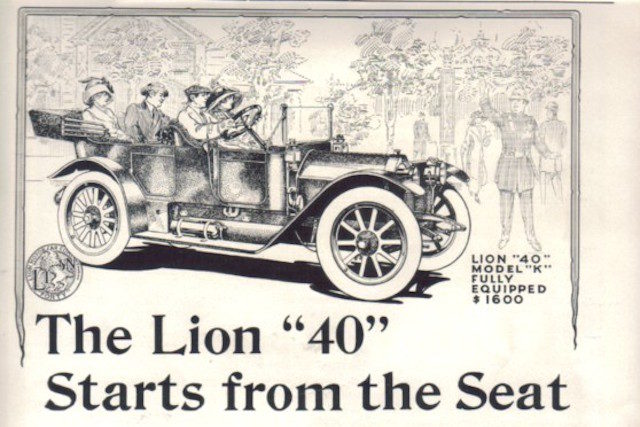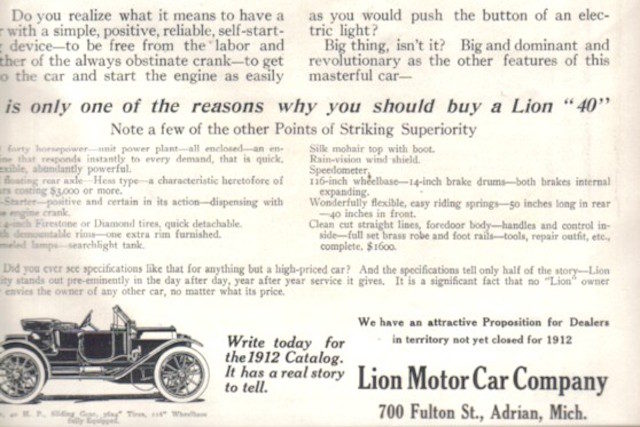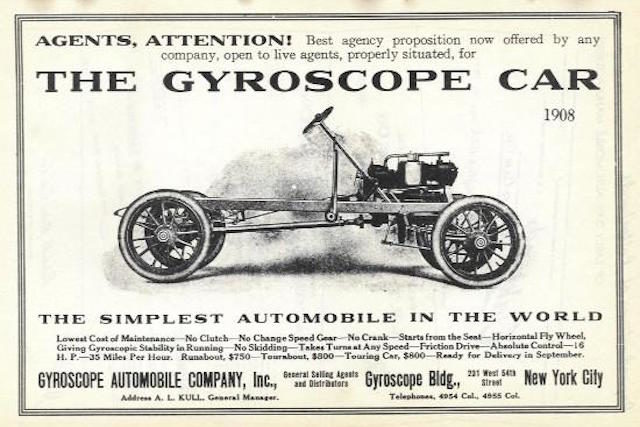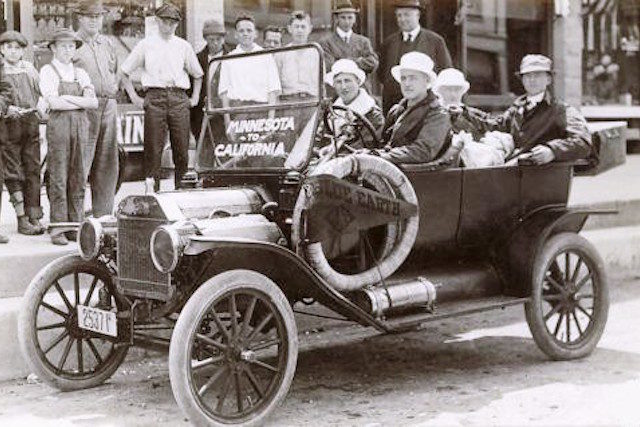 [1]
[1]The Lion 40 was set to propel the automaker into superstar status. Photos from www.american-automobiles.com [2]
One of America’s most unique automobile manufacturers, and the hope of a city, went up in flames on June 2, 1912. The Lion Motor Car Company, pride of Adrian, Michigan, had flames gut the factory and burned to the ground in a short three hour period. Ironically, a light rain helped put out the fire after the damage had been done. The Captain of Adrian’s Hose Company Number 3 was killed by a falling wall during the blaze.
Adrian, Michigan, had been known as the Fence Capital of the world after a local inventor had discovered how to manufacture wire fencing. The wire fence business was moving to other areas like Pennsylvania and New Jersey, so having a start up automotive company take up residence in the small town was a welcomed. The auto company moved into the Lion Fence Company plant, took over the Lion name and producing their own products.
Lion Car Company employed about 300 workers and sold a four-cylinder 40-horsepower engine that was available in three different body types with the 1912 model selling for $1,600. These were considered a well-built, reasonably priced cars.
What made this company’s products unique was the Gyroscope car. Named because its engine was mounted horizontally with the crankshaft vertical. The flywheel was situated in a horizontal plane under the cylinders. Originally developed by C. H. Blomstrom, owner of the C. H. Blomstrom Manufacturing Company, the Gyroscope engine was rated at 16 horsepower.
Blomstrom claimed the Gyroscope engine offered better stability and prevented skidding. The engine was mounted to a friction transmission and a driveshaft to power the wheels. The different engine was available in the common body styles: a Runabout, a Tourabout, and a full Touring car.
Carl Blomstrom sold the Gyroscope and all rights to the cars to the Lion Motor Car Company, which was being run by Fred Postal and Henry Bowen at that time. After a little work, the Lion Motor Car Company produced a new car, the Lion 40 Model K, that produced a whooping 40 horsepower.
Things were going well for Lion Motor Car Company and the Gyroscope car until June 2, 1912 when the fire started in the assembly room among a number of the cars. The local newspaper, The Telegram, reported: “Fortunately, a number of men at work are also on the fire department and made use of their knowledge to extinguish the blaze. Their quick work averted a much larger disaster.”
The fire destroyed more than 150 nearly finished cars in the factory, as well as a new, less-expensive Model Thirty prototype the company had high hopes for. For the company, the loss represented about 8 million dollars in today’s money. The company was forced into bankruptcy.
A later court case was brought up in 1914 that accused the Lion Motor Car Company executives of killing the Gyroscope cars in favor of the more conservative Lion Touring cars with standard designed engines. This put a financial burden on the Blomstrom Manufacturing Company which had a contract to supply the Gyroscope engine to Lion Motor Car. Blomstrom was forced to declare bankruptcy and both companies went out of business.


